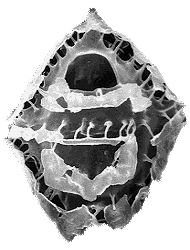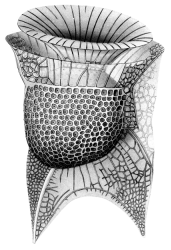Difference between revisions of "Main Page"
| Line 35: | Line 35: | ||
*[[ACKNOWLEDGEMENTS]] | *[[ACKNOWLEDGEMENTS]] | ||
*[[CONTACTS]] | *[[CONTACTS]] | ||
| − | |||
__NOTOC__ | __NOTOC__ | ||
Revision as of 23:43, 31 August 2015
 |
DINOFLAJ2 |
 |
| Scanning electron micrograph of Charlesdowniea clathrata, an Eocene fossil dinoflagellate cyst (dinocyst) from Maryland, U.S.A. Image courtesy of Dave Goodman. | Line drawing of Ornithocercus formosus, a living dinoflagellate. Figure from Kofoid and Skogsberg (1928). |
Update: new software
09/2015: We have updated the software used in Dinoflaj2. Content is the same, but the change has enabled moving to a new server and fixed some long-standing bugs. There are also some additional ways to browse the data using the sidebar on the left (e.g., to view only calcareous fossil dinoflagellates -- see "Other Groupings"). The software uses a newer version of MediaWiki with the addition of Semantic MediaWiki extensions.
WHAT IS DINOFLAJ2?
DINOFLAJ2 is a database system containing:
1. An index of fossil dinoflagellates at generic, specific and infraspecific ranks. This information will be updated periodically, as explained below, but initial data (2005/08/01) is from Fensome and Williams (2004).
2. The classification of fossil and living dinoflagellates down to generic rank, where it is continuous with the index information. The classification will be updated periodically, but initial data is based on the classification of Fensome et al. (1993).
3. Other information and illustrations on fossil dinoflagellates as appropriate and available, including full reference information updated from the above sources and a glossary of terms.
All information is hyperlinked for convenient browsing. DINOFLAJ2 supersedes, and is a successor of, DINOFLAJ (Geological Survey of Canada Open File 3653), which was distributed as a website and CD from 1998 to 2004. Information will be updated periodically in the form of a new version of DINOFLAJ2. In order to avoid confusion, it is recommended that, in citations of this database, the version of DINOFLAJ2 always be indicated. Past versions will be archived.
This version of DINOFLAJ2 should be cited as: Fensome, R.A., MacRae, R.A. and Williams, G.L., 2005. DINOFLAJ2, Version 1. Geological Survey of Canada, Data Series no. 1.
WHAT ARE DINOFLAGELLATES?
Dinoflagellates are single-celled organisms that have two distinctive flagella during at least part of their life cycle and/or a special type of nucleus called a dinokaryon (Fensome et al., 1993b). They are probably best known as a principal cause of "red tides" and paralytic shellfish poisoning. Some groups produce resistant organic-walled, calcareous or (rarely) siliceous cysts that are preserved in Mesozoic and Cenozoic sediments and sedimentary rocks. These fossils are useful in helping to determine ages of rocks (e.g. in understanding petroleum systems) and in understanding past environments (e.g. global change studies).